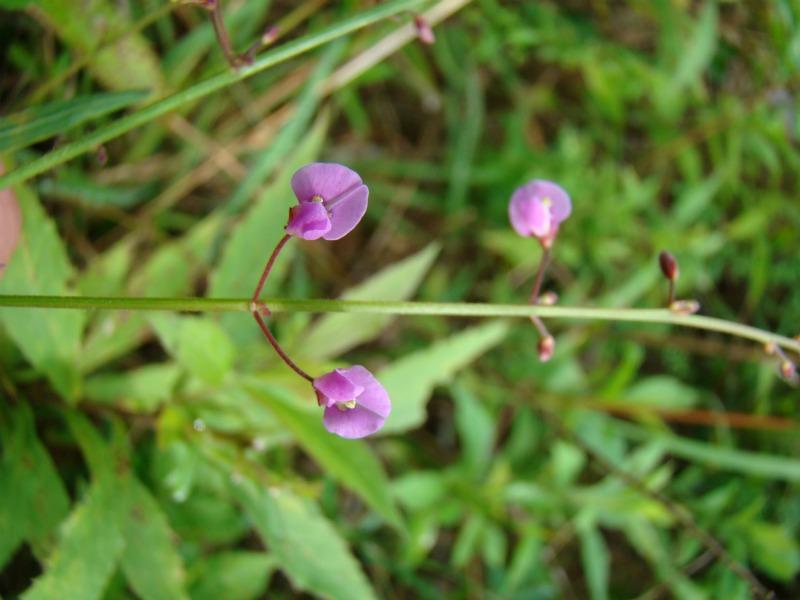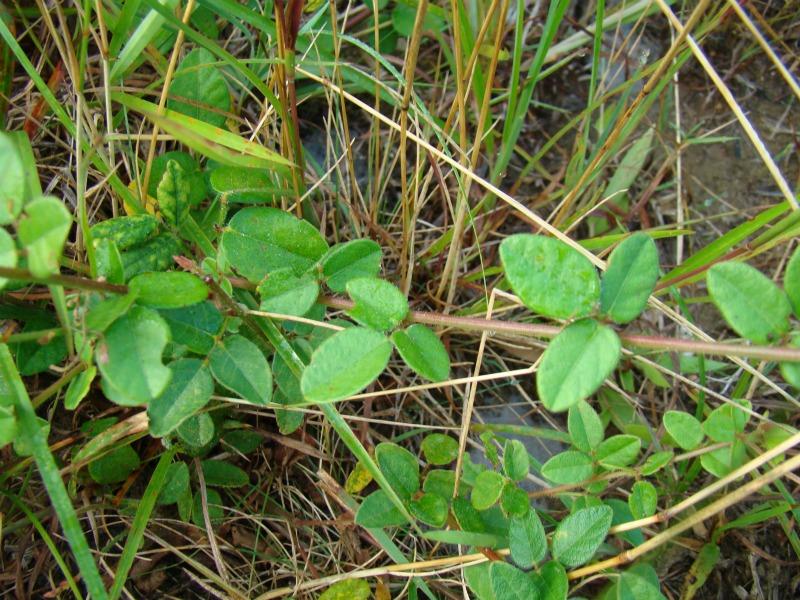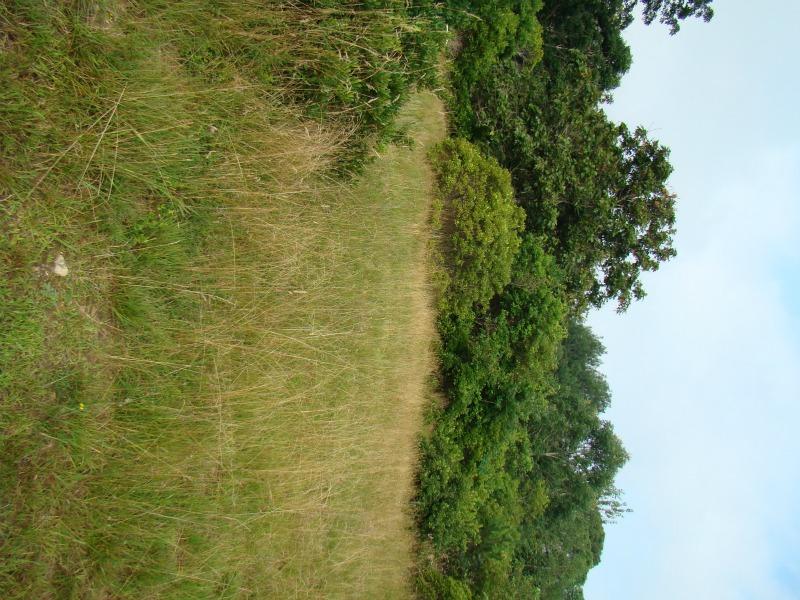Hairy Small-leaved Tick Trefoil
Desmodium ciliare (Muhl. ex Willd.) DC.
- Class
- Dicotyledoneae (Dicots)
- Family
- Fabaceae (Pea Family)
- State Protection
- Threatened
Listed as Threatened by New York State: likely to become Endangered in the foreseeable future. For animals, taking, importation, transportation, or possession is prohibited, except under license or permit. For plants, removal or damage without the consent of the landowner is prohibited.
- Federal Protection
- Not Listed
- State Conservation Status Rank
- S2S3
Imperiled or Vulnerable in New York - Very vulnerable, or vulnerable, to disappearing from New York, due to rarity or other factors; typically 6 to 80 populations or locations in New York, few individuals, restricted range, few remaining acres (or miles of stream), and/or recent and widespread declines. More information is needed to assign either S2 or S3.
- Global Conservation Status Rank
- G5
Secure globally - Common in the world; widespread and abundant (but may be rare in some parts of its range).
Summary
Did you know?
Little-leaf Tick-trefoil has the shortest leaflets of any Desmodium in New York State. Historical records show the species occurring across the state south of the Adirondacks in open sandy areas, similar to the areas where blue lupine is found. It should be looked for where lupine has been seen. Presently it is known only from Long Island and the Syracuse and Rochester areas.
State Ranking Justification
There are 16 existing populations, but only 3 of them have more than 100 plants, although the largest has more than 5000. There are 49 historical occurrencess and many have not been checked.
Short-term Trends
The larger populations seem stable, but three smaller populations were not rediscovered in recent surveys and most likely have been extirpated.
Long-term Trends
There are many historical records which have not been rechecked, so the true long-term trend is unknown. The larger populations will probably remain viable into the foreseeable future.
Conservation and Management
Threats
Since many of these populations occur within small natural areas they are threatened by direct development, indirect consequences of development such as increased human use of trails and dumping, and by the failure to control invasive species such as white sweet clover and autumn olive.
Conservation Strategies and Management Practices
This species needs disturbance to reduce competition, but too much direct disturbance to the plants will reduce the population. Its habitat could be disturbed in the non-growing season to open it up for seed germination and colonization, but direct disturbance should be prevented during the growing season.
Research Needs
The amount and type of disturbance needed by this species should be studied.
Habitat
Habitat
In New York, Desmodium ciliare has been found in a variety of dry, open habitats, including oak openings, openings and roadsides within pitch-pine forests, and sandy or rocky summit grasslands (New York Natural Heritage Program 2010). Dry sandy woods and clearings (Fernald 1950). Dry, often sandy soil (Gleason 1952).
Associated Ecological Communities
- Dwarf pine plains
(guide)
A woodland community dominated by dwarf individuals of pitch pine and scrub oak that occurs on nearly level outwash sand and gravel plains in eastern Long Island. The soils are infertile, coarse textured sands that are excessively well-drained.
- Hempstead Plains grassland*
(guide)
A tall grassland community that occurs on rolling outwash plains in west-central Long Island. This community occurs inland, beyond the influence of offshore winds and salt spray.
- Mowed roadside/pathway
A narrow strip of mowed vegetation along the side of a road, or a mowed pathway through taller vegetation (e.g., meadows, old fields, woodlands, forests), or along utility right-of-way corridors (e.g., power lines, telephone lines, gas pipelines). The vegetation in these mowed strips and paths may be dominated by grasses, sedges, and rushes; or it may be dominated by forbs, vines, and low shrubs that can tolerate infrequent mowing.
- Oak openings
(guide)
A grass-savanna community that occurs on well-drained soils. In New York, these savannas originally occurred as openings within extensive oak-hickory forests. The best remnants occur on dolomite knobs.
- Pitch pine-heath barrens
(guide)
A shrub-savanna community that occurs on well-drained, sandy or rocky soils. The most abundant tree is pitch pine and the shrublayer is dominated by heath shrubs.
- Pitch pine-oak forest
(guide)
A mixed forest that typically occurs on well-drained, sandy soils of glacial outwash plains or moraines; it also occurs on thin, rocky soils of ridgetops. The dominant trees are pitch pine mixed with one or more of the following oaks: scarlet oak, white oak, red oak, or black oak.
- Pitch pine-oak-heath woodland*
(guide)
A pine barrens community that occurs on well-drained, infertile, sandy soils. The structure of this community is intermediate between a shrub-savanna and a woodland. Pitch pine and white oak are the most abundant trees.
- Rocky summit grassland
(guide)
A grassland community that occurs on rocky summits and exposed rocky slopes of hills. Woody plants are sparse and may be scattered near the margin of the community. Small trees and shrubs may be present at low percent cover.
* probable association but not confirmed.
Associated Species
- Pinus rigida (pitch pine)
- Schizachyrium scoparium
Range
New York State Distribution
This herb has been collected throughout most of the state south of the Adirondacks, but most current records are known from Long Island.
Global Distribution
Desmodium ciliare reaches its northeastern limit in New York and Massachusetts. It extends west to Michigan, Missouri, and Kansas and south to Texas and Florida.
Identification Comments
General Description
Little-leaf Tick-trefoil is a perennial herb species of the pea or legume family (Fabaceae). It has erect stems from 0.4 to 1.0 meters tall, with long, spreading hairs. The clover-like leaves are compound, divided into 3 leaflets, and on petioles 2 to 10 mm long (and also spreading-hairy). The leaflets are 1.5 to 2.5 cm long, ovate-oblong to oval, blunt, and range from sparsely hairy to nearly glabrous. The flowers have the familiar "winged" shape of the pea family, and are 4-5 mm long (Gleason and Cronquist 1991). Their color may range from nearly purple to nearly white. The fruit separate into seeds covered with tiny, hooked hairs, well-dispersed by human socks and pant-legs.
Best Life Stage for Proper Identification
Stems with both leaves and flowers are needed to identify this species.
Similar Species
Desmodium marilandicum has essentially glabrous leaves, and its petioles equal the lateral leaflets (1.2-2.7 cm long), while D. ciliare has pubescent leaves with the terminal leaflet longer than the petiole.
Best Time to See
Little-leaf Tick-trefoil flowers from mid-July to mid-September, and the fruits persist until the first frost.
- Vegetative
- Flowering
- Fruiting
The time of year you would expect to find Hairy Small-leaved Tick Trefoil vegetative, flowering, and fruiting in New York.
Hairy Small-leaved Tick Trefoil Images
Taxonomy
Hairy Small-leaved Tick Trefoil
Desmodium ciliare (Muhl. ex Willd.) DC.
- Kingdom Plantae
- Phylum Anthophyta
- Class Dicotyledoneae
(Dicots)
- Order Fabales
- Family Fabaceae (Pea Family)
- Order Fabales
- Class Dicotyledoneae
(Dicots)
- Phylum Anthophyta
Additional Common Names
- Little-leaf Tick Trefoil
- Tick-clover
- Tick-trefoil
Synonyms
- Hedysarum ciliare Muhl.
- Meibomia ciliaris (Muhl. ex Willd.) Blake
- Meibomia obtusa (Muhl. ex Willd.) Vail [Misapplied to NY specimens.]
Additional Resources
References
Fernald, M.L. 1950. Gray's manual of botany. 8th edition. D. Van Nostrand, New York. 1632 pp.
Gleason, Henry A. and A. Cronquist. 1991. Manual of Vascular Plants of Northeastern United States and Adjacent Canada. The New York Botanical Garden, Bronx, New York. 910 pp.
Holmgren, Noel. 1998. The Illustrated Companion to Gleason and Cronquist's Manual. Illustrations of the Vascular Plants of Northeastern United States and Adjacent Canada. The New York Botanical Garden, Bronx, New York.
Mitchell, Richard S. and Gordon C. Tucker. 1997. Revised Checklist of New York State Plants. Contributions to a Flora of New York State. Checklist IV. Bulletin No. 490. New York State Museum. Albany, NY. 400 pp.
New York Natural Heritage Program. 2010. Biotics database. New York Natural Heritage Program. New York State Department of Environmental Conservation. Albany, NY.
New York Natural Heritage Program. 2024. New York Natural Heritage Program Databases. Albany, NY.
Weldy, T. and D. Werier. 2010. New York flora atlas. [S.M. Landry, K.N. Campbell, and L.D. Mabe (original application development), Florida Center for Community Design and Research http://www.fccdr.usf.edu/. University of South Florida http://www.usf.edu/]. New York Flora Association http://newyork.plantatlas.usf.edu/, Albany, New York
Links
About This Guide
Information for this guide was last updated on: February 23, 2011
Please cite this page as:
New York Natural Heritage Program. 2024.
Online Conservation Guide for
Desmodium ciliare.
Available from: https://guides.nynhp.org/little-leaf-tick-trefoil/.
Accessed July 27, 2024.



